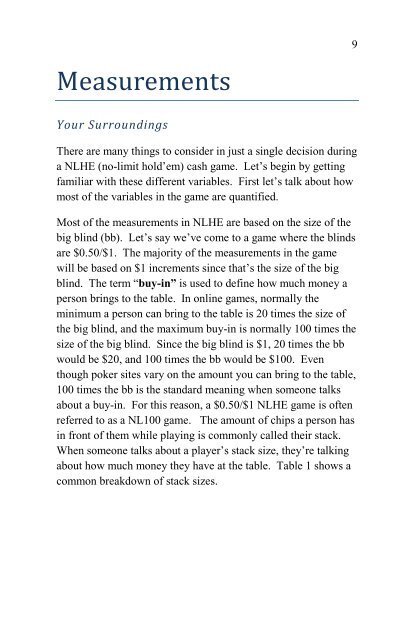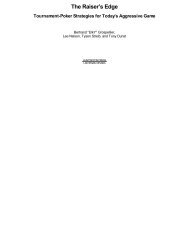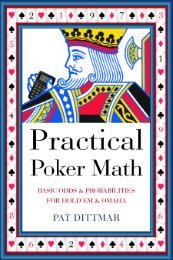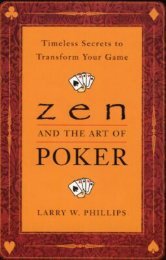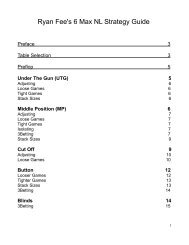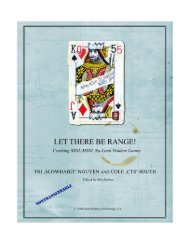- Page 2 and 3: Poker Math That Matters Simplifying
- Page 4 and 5: Table of Contents Acknowledgements
- Page 6 and 7: Set-Mining ........................
- Page 8: Acknowledgements One of the most va
- Page 11 and 12: xi poker fits my family's lifestyle
- Page 13 and 14: 2 Throughout this book, you will se
- Page 15 and 16: 4 Let’s talk a bit about how to d
- Page 17 and 18: 6 want to just play, play, and play
- Page 22 and 23: Another measurement to understand i
- Page 24 and 25: those sections. For a beginning pla
- Page 26 and 27: Thinking About Bets in No-Limit Hol
- Page 28 and 29: Here's why this works. If we were t
- Page 30 and 31: playing at a 6-max table, he’ll p
- Page 32 and 33: money for a while and not even be c
- Page 34 and 35: Getting Started with Numbers Workin
- Page 36 and 37: The last topic to cover in this sec
- Page 38 and 39: doesn’t happen to complete our ra
- Page 40 and 41: Expectation Value You’re walking
- Page 42 and 43: 0.5 * (-$10) = (-$5) Now let’s do
- Page 44: Quiz (Answers on pg. 158) 1. Someon
- Page 47 and 48: 36 left to come on the river. What
- Page 49 and 50: 38 Hero: 6♠7♠ Villain: A♣K♦
- Page 51 and 52: 40 TT88A. Your opponent’s best ha
- Page 53 and 54: 42 Gutshot straight draw (aka Gutte
- Page 55 and 56: 44 you’ll need to add these toget
- Page 57 and 58: 46 9. Hero: Q♦K♥ Villain: A♠J
- Page 59 and 60: 48 19. Hero: A♠Q♣ Villain: 5♣
- Page 61 and 62: 50 The 4/2 Rule I hope you’ve tak
- Page 63 and 64: 52 pretty simple, right? But, of co
- Page 65 and 66: 54 Let’s try one more. Hero: J♥
- Page 67 and 68: 56 We can multiply these fractions
- Page 69 and 70:
58 4. Hero: 9♦6♦ Villain: J♦J
- Page 71 and 72:
60 So, the equation looks like this
- Page 73 and 74:
62 We have a flush draw. The pot is
- Page 75 and 76:
64 Quiz (Answers on pg. 174) For th
- Page 77 and 78:
66 Implied Odds In this section, we
- Page 79 and 80:
68 Table 6. Multiplication factor t
- Page 81 and 82:
70 3. Hero: A♣Q♦ Villain: J♦J
- Page 83 and 84:
72 When we look at the hand range s
- Page 85 and 86:
74 Figure 7. Two groups containing
- Page 87 and 88:
76 the probability distribution of
- Page 89 and 90:
78 the suited A holdings villain co
- Page 91 and 92:
80 8. Hero: 5♥6♥ Villain: 99, Q
- Page 93 and 94:
82 section. As usual, we’ll talk
- Page 95 and 96:
84 Now, obviously we’re going to
- Page 97 and 98:
86 AA: 3 combinations- 12% KK: 3 co
- Page 99 and 100:
88 2. Hero: J♠A♠ Villain: QQ, K
- Page 101 and 102:
90 So, we lost $360 in Sklansky-buc
- Page 103 and 104:
92 Quiz (Answers on pg. 184) Calcul
- Page 105 and 106:
94 Take a second and think about th
- Page 107 and 108:
96 make that bet. Looking at the EV
- Page 109 and 110:
98 2. Hero: 5♠4♠ Villain: Fold
- Page 111 and 112:
100 Let's do a quick exercise to es
- Page 113 and 114:
102 39x - 7.56 + 7.56x > 0 46.56x >
- Page 115 and 116:
104 $81(0.24) = $19.44 2. Our shove
- Page 117 and 118:
106 Quiz (Answers on pg. 188) Assum
- Page 119 and 120:
108 Value-Betting Value-betting is
- Page 121 and 122:
110 and we’ll give him a $500 sta
- Page 123 and 124:
112 only the hands that beat us. Ou
- Page 125 and 126:
114 2. Hero: K♥Q♥ Villain: Call
- Page 127 and 128:
116 7. Hero is out of position: K
- Page 129 and 130:
118 and then consider your pot odds
- Page 131 and 132:
120 Quiz (Answers on pg. 197) 1. Ho
- Page 133 and 134:
122 Seems like a small thing, right
- Page 135 and 136:
124 all sorts of As, Js and Ts in h
- Page 137 and 138:
126 Quiz (Answers on pg. 198) 1. Wh
- Page 139 and 140:
128 First of all, the above calcula
- Page 141 and 142:
130 past hands may cause you to twe
- Page 143 and 144:
132 would want to get the money in
- Page 145 and 146:
134 he can call profitably, if we h
- Page 147 and 148:
136 It's obviously a mistake for hi
- Page 149 and 150:
138 4. Hero: Q♣Q♦ Villain: 8♣
- Page 151 and 152:
140 decision may be a totally diffe
- Page 153 and 154:
142 adjustment. So, in order to avo
- Page 155 and 156:
144 balanced poker every day of the
- Page 157 and 158:
146
- Page 159 and 160:
148 Congratulations on making your
- Page 161 and 162:
150 Comparing these two bet sizes,
- Page 163 and 164:
152 So, we're still better of betti
- Page 165 and 166:
154 Your Surroundings Quiz Answers
- Page 167 and 168:
156 2. If you played 10,000 hands b
- Page 169 and 170:
158 Answer: Probability is 2 6 odds
- Page 171 and 172:
160 4. Someone holds out a deck of
- Page 173 and 174:
162 4. Hero: 5♣7♣ Villain: K♦
- Page 175 and 176:
164 9. Hero: Q♦K♥ Villain: A♠
- Page 177 and 178:
166 14. Hero: 7♠8♠ Villain: 9
- Page 179 and 180:
168 18. Hero: A♠5♠ Villain: A
- Page 181 and 182:
170 22. Hero: 4♠5♠ Villain: A
- Page 183 and 184:
172 The 4/2 Rule Quiz Answers 1. He
- Page 185 and 186:
174 6. Hero: Q♦Q♥ Villain: A♥
- Page 187 and 188:
176 4. Hero: 9♦6♦ Villain: J♦
- Page 189 and 190:
178 Combinations Quiz Answers 1. He
- Page 191 and 192:
180 7. Hero: 6♥7♠ Villain: QQ,
- Page 193 and 194:
182 2. Hero: J♠A♠ Villain: QQ,
- Page 195 and 196:
184 outs for 6% equity. Against 66,
- Page 197 and 198:
186 Bluffing Quiz Answers 1. Hero:
- Page 199 and 200:
188 Answer: A 1/3 pot bet must work
- Page 201 and 202:
190 $24 - $14 = $10 We’re risking
- Page 203 and 204:
192 0.57($20) + 0.43(-$20) = EV 11.
- Page 205 and 206:
194 4. Hero: A♦J♦ Villain has $
- Page 207 and 208:
196 6. Hero is out of position: K
- Page 209 and 210:
198 2. How often will you flop an o
- Page 211 and 212:
200 2. What are some of the factors
- Page 213 and 214:
202 5. When might we allow some dra
- Page 215 and 216:
204
- Page 217 and 218:
206 Chopping Outs: Cards to come th
- Page 219 and 220:
208 Offsuit: Hole cards that do not
- Page 221 and 222:
Owen Gaines also wrote Hole Card Co


